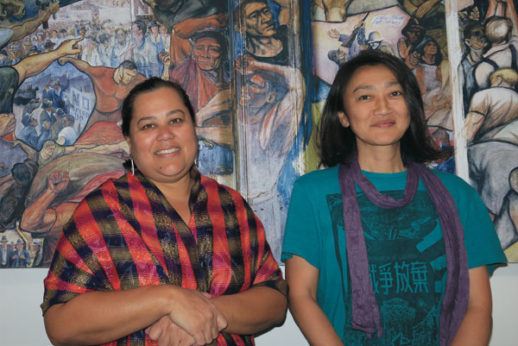
Dr. Lisa Linda Natividad is an assistant professor at the University of Guam (Univetsedat Guahan) in the College of Natural and Applied Sciences and an activist in the cause of peace and social justice. She was recently in Australia to speak at the Independent and Peaceful Australia Network (IPAN) forum. While in Sydney en route to Alice Springs for the conference, Dr. Natividad spoke to Anna Pha from the Guardian newspaper about the U.S. military build-up in Guam. Their interview is reprinted here from the Guardian.
Guardian: Perhaps we could start with you giving readers some background information on Guam?
Lisa Natividad: Guam is an Island in the Mariana chain which is located in the Micronesia region of Oceania. Politically we are an unincorporated territory of the United States of America, which is equivalent to a modern day colony. We’ve been under the United States’ colonization since 1898 following the Spanish-American war.
Prior to that we were colonized by Spain, with the first contact with the outside world in 1521. So Guam remains a U.S. colony. We are on the UN list of non self-governing territories, of which there are only 17 left in the world.
I am Chamorro. We are the Indigenous people, the native people of the islands. When I say the islands, I am not just talking of Guam but of the Mariana Islands. We are about 37 percent of the population on the island. The island has roughly 160,000 people.
G: How big is the military presence?
LN: The U.S. Department of Defense occupies about 31 percent of the island. There is a heavy U.S. military population. It is roughly 15,000 troops. With the Guam military build-up and the transfer of Marines slowly from Okinawa that is happening now, it is hard for us to keep track.
They do not reveal to us exactly what they are doing, and beyond that a huge number of people are coming through who are on what they call a rotational basis. So we can never really tell on any particular day how many people are there.
G: What’s the impact on the local people?
LN: It is having a tremendous impact. I’ll give you an example. Just a few days ago, Operation Valiant Shield ended. With Operation Valiant Shield, they had brought in about 18,000 people representing all the different branches of the U.S. military.
Mind you, the island is about 212 square miles. It’s small.
The Valiant Shield exercise included an aircraft carrier. The total number of aircraft was almost 300. That’s just all connected to one exercise that happens every two years for 10 days.
When you think about such a militarized environment, and this has been happening for so long, as a community we have become very desensitized to their presence.
In addition to dealing with the physical reality of the military presence, the things we are most concerned about include the economics. While economic prosperity is a huge part of why the build-up is justified and supported by many people at home, it really does not trickle down to the local community.
The corporate companies that come in make a lot of money; there are elites who make a lot of money around the military build-up. However, the average person on Guam, the Chamorro on Guam, does not benefit from the military presence.
So you have a really bad economic situation for various reasons. One of those reasons is that as a territory of the U.S., we are only eligible for one seventh of funding that is available to states.
So to begin with our coffers are small. We have a small tax base because we have a small population with very little wealth. So you have a situation of poverty basically – the Chamorro of course being one of the most impacted ethnic groups on the island in terms of the economics. As a result of that, our kids have the highest rate of enlistment in the U.S. military because it is seen as an opportunity to have some economic mobility.
In addition, the current price tag for the military build-up and transfer of Marines from Okinawa is about $18 billion USD and the majority of that money is going to be spent inside the military bases.
It is to develop military bases so there is no trickle down, no crossing that fence in sharing the wealth, so to speak. At the same time, while the number of troops is about 5,000 – that is the number being transferred – that number doesn’t include families, doesn’t include contractors, or contract labor workers who will be coming to build up these bases.
So when you’ve got contract labor workers, for example, that may come from Asia or wherever, you also have to consider where their needs are going to be met. If they get sick, what hospital do they go to? It’s not the military hospital. They will be utilizing, living, and consuming everything on the civilian side of the fence.
So what essentially that means is that as a civilian community we end up bearing the burden of having to provide the services that are needed for these people, other than the military troops.
G: Has the traditional means of subsistence of the Chamorro been affected, your gardens, your fishing?
LN: Absolutely. We have tried very hard to get native fishing rights restored, at least for Chamorro people who use traditional practices, where there are still reserves of fish left. It is done in a way that is in concert with the environment. That has not been able to get through.
In addition to that, and probably one of the things that is of the biggest concern to us in terms of our traditional practices, is being able to get the traditional plants or medicines we use. This is because the traditional medicines specifically grow in areas that have very precise conditions meaning sometimes they need the seawater, sometimes they need a specific kind of rock, and what have you.
A lot of those traditional medicines are behind the gates. They will be clearing these for the base. They will invite traditional healers to come in, survey the medicines that are available, pick the medicines they need, but they cannot even uproot the plant to take and replant it.
The reason given for that is unexploded ordinances underneath the soil. Even if we were to uproot it and bring it somewhere else, it would not maintain its medicinal properties because it doesn’t have the environment it needs to grow.
So that is the second thing that is of great concern to us. We can’t replicate that anywhere else. They need to just let us keep it. But they are not willing to do that. That’s been a big push in terms of our community.
The third thing, when I came to Australia in 2008, they had not released the draft environmental impact statement (EIS) on the Guam build-up of the transfer of these Marines. So we did not know a lot of the detail then. But finally they had to release a report.
That report, for the first time, gave us details of how they were planning to do this build-up. What was revealed in 2009 is that they wanted to take an ancient village called Pagat [to build] a live firing range complex with five different ranges.
This is a traditional, ancient village and they wanted to take from the ocean all the way up to the mountain. So we resisted that; we actually filed a lawsuit against the U.S. Department of Defense. The grounds for our lawsuit were that they had not explored other alternatives as per the National Environmental Protection Act (NEPA) process.
So we were able to win that lawsuit. They reviewed the process which bought us more time – a couple of years. They considered three more places and ended up selecting a place called Litekyan. It is an ancient village which is located in Retidian Point. Retidian Point is way bigger than Pagat.
So the same destruction that they were going to do to Pagat will be done on a bigger scale at Litekyan.
On top of all that, horrific as it is, the U.S. Congress passes and enacts a law that does not allow us to sue them on this choice. So we no longer have legal remedies that we can use to address this situation.
G: So have they started building the base there?
LN: The first step is clearing the land. They are in the process of offering the medicines before that. They are in the very formative stages of progressing that plan.
G: Is there a struggle, a movement against that?
LN: In 2009, when the draft EIS was initially released, from a community of roughly 160,000 people, the Department of Defense received over 10,000 comments on our issue.
So when you look at our population, what that means is it was huge. Even the DoD said it was unprecedented in its history to have that kind of response from a community.
And here’s the other thing that we don’t even often mention, but it was so injurious at the time, their report was 11,000 pages. We had 90 days to respond to it. Do you know what 11,000 pages looks like all stacked!
They put everything under one big EIS which disarmed us because we were not able to respond to all of this. So our collective response raised a number of concerns.

Twenty-two additional water wells. Mind you we don’t have a lot of water to begin with.
They are going to dredge 72 acres of live coral reef to do a berthing for the submarines. Because of our resistance, they said okay we are putting this on the shelf. We are not going to deal with this right now. But now they are doing it in stages.
They are going to get back to that in the development of the missile defense system which connects with Pine Gap.
There is a very long list of things that we are concerned about.
There is the right to self-determination so that we can be decolonized politically.
It’s just outrageous.
G: What impact do you think the U.S.’ security pivot to this region is having?
LN: With the Obama administration, the pivot strategy has increased funding in the Asia-Pacific region for militarization. So clearly there is this expansion.
We spend so much time talking about the connection with Okinawa and the transfer of these Marines, but what’s even more horrible is that since then in 2010 and in 2013, the U.S. continued its build-up around the Marianas with two particular plans.
One is called the MIRC, which is the Marianas Island Range Complex, and the other is called a MITT – Marianas Island Training and Testing.
They are both training areas. What they have done essentially is claimed for military use ocean space that spans way beyond our borders, that surrounds the Marianas Islands, and almost all the way up to Palau.
They have not just claimed land space anymore. It’s almost a million acres of ocean space and airspace. They are laying claim for ownership of the ocean and the resources of the ocean.
For example, they have just claimed the resources of the Marianas Trench which are clearly our resources. They transferred it to one of their trust relationships with their freely associated states.
My guess is that they did that because it allows them through their free association agreement to exploit the Trench.
So when you are looking at things like geothermal development, for example, the huge bountiful minerals that are contained in those ocean spaces, it really calls to question their true intention in claiming the ocean.
G: What do you see as the purpose of this military build-up? What is the main target?
LN: China clearly. I think it is very clear that the target of the pivot is China. Sometimes they will say North Korea, but no, it is China.
I think the most important thing for me is that the U.S. is going about the world with its militarist agenda in the name of democracy. Yet there is nothing democratic about what the U.S. is doing on Guam, or what it is doing anywhere else.










